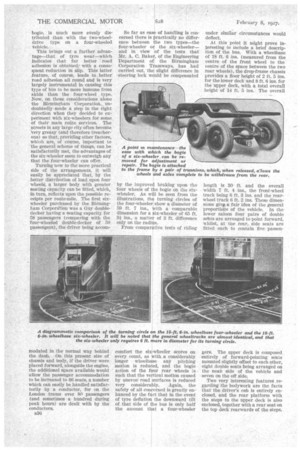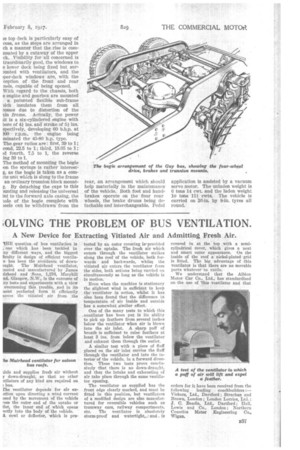IIRMINGHAM CORPORATION'S BUS PROGRESS.
Page 133

Page 134

Page 135

If you've noticed an error in this article please click here to report it so we can fix it.
The Pros and Cons of the Omnibus for Use in and around Large Cities. An Instance where the Tramcar Costs Less to Operate than the Bus.
'T is generally contended that .trams. trolley-buses and petrol tses all have their own particular ;efulness in the general transport the inhabitants of large cities, and is a matter calling for judgment on e part of the engineer in charge of fairs as to just which particular Pe of vehicle is most suited to cerin special conditions at various nes of the day and week.
The position of Birmingham in is respect is very interesting, as e Corporation has had a fleet of trol buses—considerably over 100 ; a matter of fact—running on cerin services for a long time, in addion, of course, to a network of tram lutes. Recently, a new and imroved type of bus has been running ong certain routes for test purwes, the experience gained with the ;flier type being taken as a guide ir development. It will, therefore, rove interesting to see how the in2ence of competition and other Lctors prevailing in large cities red the type of vehicle to be used 0 meet the personal demands of the lic and, withal, to make the roposition sound upon an economic Isis.
Tramcars have for some years ist been subjected to very untvourable comparison with the her types of vehicle—trolley-buses Id patrol buses—but for peak-hour :rvices, that is, the times when lost of the population are going to id from business, the bigger ipacity of the trams provides a nicker and more convenient form of ansport, especially where comparavely short distances are covered. On the other hand, for what might termed main-road routes the strol bus scores, particularly where te stopping places are spaced at nnewhat infrequent intervals. Again, the cost of relaying tramways over long distances (this term is used in the comparative sense only) is very high and usually necessitates quite a large proportion of the road being held up, resulting in congestion, whilst the route is interrupted and passengers have to get out of one car and walk along the portion under repair to another car in order to finish the journey. Petrol buses. however, do not suffer from the same disability, as alternative routes to miss the portion of road under repair can be taken, and so, practically, a minimum of inconvenience is caused to the passengers.
That the bus does not have it all Its own way is exemplified by the fact that, in Birmingham, the tramcar seating from 60 to 80 passengers costs less to operate than the motor omnibus which only seats 52, even including the cost of permanent-way repairs and all other factors attendant upon the service, so that, although the first cost of introducing a new route service is considerably less with the petrol bus, it does not always work out "such an econ-Biniral proposition after the service has been in use for some years.
It is, of course, only of recent years that the pneumatic-tyred vehicle has been seen in any numbers on public services, and, there is no doubt that it has been largely instrumental in causing the rapid development to tap place. Still more recently, the six-wheeled vehicle with pneumatic tyres has made its appearance and, from early tests, promises to supersede the other types in the very near future.
In the first place, road maintenance becomes an important and expensive item where petrol buses are running a constant service, so that any steps which will mitigate the destruction of the roads should cause it to become popular with the highway authorities at any rate. In this respect, the six-wheeler scores heavily, as the load per wheel is reduced to a considerable degree (even though the bus be large), whilst the drive to be transmitted, if taken through all the four wheels of the bogie, is much more evenly distributed than with the two-wheeldrive type on a four-wheeled vehicle.
This brings out a further advantage—that of tyre wear—which indicates that far better road adhesion is obtained;with a consequent reduction in slip. This latter feature, of course, leads to better road adhesion all round and is very largely instrumental in causing this type of bus to be more immune from skids than the four-wheel type. Now, on these considerations alone the Birmingham Corporation., undoubtedly made a step in the right direction when they decided to experiment with six-wheelers for some of their main rofite services. The streets in any large city often become Very greasy (and therefore treacherous) so that, providing other factors, whicih are, of course, important to the general scheme of things, can be Satisfactorily met, the advantages of the six-wheeler seem to outweigh any that the four-wheeler can offer.
Turning now to the more practical side of the arrangements, it will easily be appreciated that, by the better distribution of load upon four wheels, a larger body with greater seating capacity can be fitted, which, in turn, reflects upon the possible receipts per route-mile. The first sixwheeler purchased by the Birmingham Corpora-lion was a Guy doubledecker having a seating capacity for 58 passengers (comparing with the four-wheeled double-decker of 50 passengers), the driver being accom
modated in the normal way behind the dash. On this pmesent size of chassis and body, if the driver were placed forward, alongside the engine, the additional space available would allow the passenger accommodation to be increased to 66 seats, a number which can easily be handled satisfactorily by a conductor, for on the London trams over 80 passengers (and sometimes a hundred during peak hours) are dealt with by the conductors.
s30 So far as ease of handling is concerned there is Practically no differ ence between the two types the four-wheeler or the six-wheelerand in view of the tests that Mr. A. C. Baker, of the Engineering Department of the Birmingham Corporation Tramways, has had carried out, the slight difference in steering lock would be compensated by the improved braking upon the four wheels of the bogie on the sixwheeler. As will be seen from the illustrations, the turning circles of the four-wheeler show a diameter of 59 ft. 7 ins., with a comparable dimension for a six-wheeler of 65 ft. 91 ins., a matter of 3 ft. difference only on the radius.
From comparative tests of riding comfort the six-wheeler scores on every count, as with a considerably longer wheelbase any pitching motion is reduced, and the bogie action of the four rear wheels is such that the vertical motion caused by uneven road surfaces is reduced very considerably. Again, the safety of all coneerned is greatly enhanced by the fact that in the event of tyre deflation the downward till of that side of the bus is only half the amount that a four-wheeler under similar circumstances would deflect.
At this point it might prove inIeresting to include a brief description of the bus. With a wheelbase of 18 ft. 6 ins. (measured from the centre of the front wheel to the centre of the space between the two rear wheels), the drop-frame chassis provides a floor height of 2 ft. 5 ins. for the lower deck and 8 ft. 6 ins, for the upper deck, with a total overall height of 14 ft. 5 ins. The overall
length is 30 ft. and the overall width 7 ft. 4 •ins., the front-wheel track being 6 ft. 3 ins, and the rearwheel track 6 ft. 2 ins. These dimensions give a fair idea of the general proportions of the vehicle. In the lower saloon four pairs of double setts are arranged to point forward, 'whilst, at the rear, side seats are fitted each to contain five passen
gers. The upper deck is composed entirely of forward-pointing seats mounted slightly offset to each other, eight double seats being arranged on the neat, side of the vehicle and seven on the off side.
Two very interesting features regarding the bodywork are the facts that the driver's cab is entirely enclosed, and the rear platform with the steps to the upper deck is also enclosed, together with a rear seat on the top deck rearwards of the steps.
ie top (leek is particularly easy of cess, as the steps are arranged in ch a manner that the rise is comnsated by a cutaway of the upper ck. Visibility for all concerned is traordinarily good, the windows to e lower deck being fixed but surminted with ventilators, and the per-deck windows are, with the ception of the front and rear neIs, capable of being opened. With regard to the chassis, both e engine and gearbox are mounted a patented flexible sub-frame lich insulates them from all resses due to distortion of the ln ireme. Actually, the power it is a six-cylindered engine with bore of 41 ins. anastroke of 5i ins. spectively, developing 60 b.h.p. at )00 r.p.m, the engine being minated the 43-80 h.p. type.
The gear ratios are : first, 39 to 1; cond, 22.5 to 1; third, 18.05 to 1; id fourth, 7.5 to 1, the reverse ing 39 to 1.
The method of mounting the bogie on the springs is rather interestg, as the bogie is taken as a coatAe unit which is slung to the frame an ordinary trunnion block mountg. By detaching the caps to this ninting and releasing the universal int to the forward axle casing, the aole of the bogie compete with ieeLs can be withdrawn' from the rear, an arrangement which should help materially in the maintenance of the vehicle. Both foot and handbrakes operate on the four rear wheels, the brake drums being detachable and interchangeable. Pedal application is assisted by a vacuum servo motor. The unladen weight is 6 tons 14 cwt. and the laden weight 10 tons 11?: cwts. The vehicle is carried on 36-in. by 8-in, tyres all round.




































































































































































































